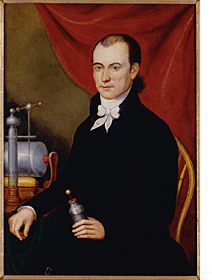
Wiley, a surveyor and Presbyterian minister, moved to Georgetown around 1800 to serve as principal of the Columbian Academy and teach natural philosophy, mathematics, geography, and Greek. Advertisements for the academy mention an "Electrical Machine"; this may be the instrument depicted in this portrait by Charles Peale Polk. Polk shared Wiley's interest in science, for he was Charles Willson Peale's nephew and had grown up in his household, where he absorbed Peale's interest in natural history, and also learned to paint. Polk's rendering of the electrical machine is puzzling. It is not likely that he misunderstood its use or construction, yet it is unlike more standard machines of this type. The cushion, which generates a charge by turning against the glass, is on the bottom rather than the side of the cylinder. The metal spikes just visible at the top of the cylinder, which collect the charge (only positive in this machine), should also be on the side. Other inconsistencies in the machine, all parts of which sit on a wooden base atop the table, may indicate that it was an unusual one, perhaps designed by Wiley. He poses proudly beside it, holding a Leyden jar, which would have been used to store an electric charge for future use.  |
 David Wiley circa 1768-1812
David Wiley circa 1768-1812